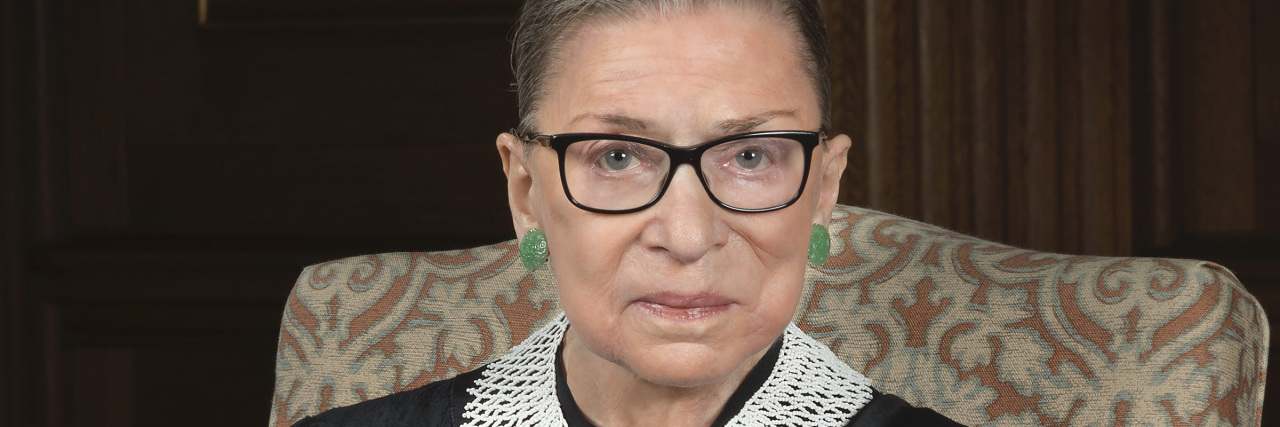The entire world was seemingly taken aback when renowned U.S. Supreme Court Justice Ruth Bader Ginsburg lost her protracted battle with cancer on September 18. After all, her resilience in the face of medical conditions had marveled many, both in the disability and health communities and among the general populace. But Ginsburg’s impact was felt beyond the fact of her tenacity. As The Mighty’s senior contributor editor Karin Willison pointed out, she was instrumental in the Olmstead decision, which paved the way for home and community-based services under the Americans With Disabilities Act as an alternative to institutionalization. The abortion-rights advocate was also a hero to feminists, breaking barriers for female lawyers and for women’s equality more generally. Additionally, Ginsburg is the first woman to lie in state in the Capitol.
While it is fair to draw strength from Ginsburg’s trailblazing nature, it serves no one to employ her story to bolster the “supercrip” narrative. The idea of the “supercrip” is one of the most common and damaging tropes propagated about disabled people and those with health conditions. In American culture, supercrips are regarded as larger-than-life overcomers of all obstacles thrown their way. While Ginsburg’s feats are no doubt extraordinary, when she is used as an example of the supercrip trope, the discourse proceeds as follows: “If the Notorious RBG can overcome cancer and other health challenges, so, too, can the average disabled person. So work harder. Strive more. And you, too, will succeed.” On the contrary, the reality is that no one, not even Ginsburg herself, has ever possessed the superhuman capacity to beat every obstacle.
In many respects, Ruth Bader Ginsburg’s resilience itself is fodder for the supercrip trope. As a 66-year-old Supreme Court Justice in 1999, she developed a cancerous tumor in her colon but didn’t miss a day on the Supreme Court, even working from the hospital. After the disease returned nearly a decade later, she came back to the bench only three weeks after surgery to remove a tumor in her pancreas. In 2014, at the age of 81, Ginsburg had to have a stent put into the right coronary artery in her heart. She was discharged from the hospital in only a matter of days, and although she would experience other health complications, she would work as a Supreme Court Justice until her recent death at the remarkable age of 87 years old.
All told, I believe the supercrip trope must be resisted in even Ginsburg’s case because it has done unquantifiable damage to the disability and health communities. Mighty contributor Claire Stanley, a blind woman who wrote an essay when she learned that she had failed the Bar Exam after graduating from UC Irvine’s School of Law, exhorted readers, “Stop thinking that people with disabilities need to be these inspirational icons who can overcome anything and everything. Yes, people with disabilities do some pretty badass things all the time. But we also face obstacles.” She continued, “Let’s stop thinking it’s either/or, that you either can’t do anything or you can do everything.”
This dichotomous thinking is a troublesome legacy of the supercrip narrative; either a disabled person languishes in poverty on Social Security Disability or thrives in riches as a working professional. This fallacious canard effectively erases the successes of the former population and the struggles of the latter category, expecting them to serve as inspirations to the larger society and to other disabled people.
Another problem with the supercrip narrative is that not everyone can be an inspiration all the time, and it is exhausting to have to constantly prove that one is an overcomer. Stanley said that she felt pressure to be the supercrip at her high school. “Because I was the only blind student in my honors classes,” she attested, “I felt like I had to work super hard to prove that blind students could do well in school, too.”
The idea that the success of the entire disability community hinges upon a single individual has a deleterious impact on all disabled achievers, not to mention that it unjustly raises the bar on everyone in the disability and health communities. After all, it is unfair to expect that every person will overcome cancer multiple times and work until she is 87 years old like Ruth Bader Ginsburg, but that doesn’t mean that people who struggle with and/or die from this disease and other conditions shouldn’t hold value in our society.
In short, our culture needs to transcend the narrative that the disability and health communities are defined by what kind of inspiration they can give to the larger society and to other disabled people. The reality is that everyone has intrinsic worth, whether or not she is a luminary who works until she is almost 90 or dies before maturity.
In the coming weeks and months, Ruth Bader Ginsburg’s legacy will be cemented in the annals of American history; after all, her legend will only rise the further removed she is from the present. While it is fair to draw inspiration from her accomplishments, we must remind people not to use her as a supercrip, the ultimate overcomer who is held as a model for disabled people and those with other health conditions. After all, having to live up to the standard set by the highest of achievers is not fair to the disability community. All disabled people will have their struggles and successes, as well as everything in between. It is important to remember that through every obstacle, disabled individuals and those with other health conditions should be treated as human beings, not as superhuman overcomers or fodder for inspiration porn.

